
14 minute read
POW Camp in Rosenberg
POW CAMP I N R O S E N B E R G
WRITTEN BY SHARON WALLINGFORD
A World War was raging overseas so why would Fort Bend county be in distress?
It was the 1940s and the area was mostly rural land that ranked high in the production of cotton, rice and cattle in the state. Electricity had yet to make its debut to most farm houses and barns, but water was abundant via windmills, cisterns and creek beds.
Life During the War

By 1943, Fort Bend County had shrunk drastically in agricultural production and was experiencing lock down under a war that was consuming its men and separating the families who met at the kitchen table every night for a fresh out-of-the-garden supper prepared at the kitchen stove. The evening meal was often followed by a session on the front porch consisting of self-told stories and songs strummed and sung to relax and cool down after a hard day of labor. A radio, usually situated in the living room, streamlined the daily news into homes; televisions were not yet common in households. The projectors at the Cole and State Theatres on Third Street flashed short reels on the war zones in black and white, along with the scheduled cartoons and hot Hollywood flicks.
Family and farm supplies had to be obtained in town or by mail order from Sears and Roebuck catalogs. The largest number of citizens (nearly 3,500) resided in Rosenberg. The city limits encompassed a radius north to the Brazos River, east along Old Richmond Road near the county fairgrounds and Fairview Courts and Café, south on SH 36 to City Hall Drive and Luksa Grocery near Southgate, and west to Fred Blasé’s City Service station and café (Tuckers) located above the intersection of SH36 and 90A.
Third Street served as the center of town. It was commonplace for the store fronts to support local activities. Local men, photographed in uniform, would hold shoppers attention for the length of the war. The
street was split by four sets of rail, divided by the railroad depot on the right and the control tower to the left. A siren on the water tower would blast to announce noon.
More than a two-mile stretch of brush and a concrete underpass divided what would become known as the twin cities of Rosenberg-Richmond, or RichmondRosenberg if a resident of Richmond.
Women learned to drive, children learned to take on more chores, and neighbors helped neighbors, but a stronger labor force was desperately needed.
German POWs Come to Texas
Soon the guttural sounds of German military began to ring clear at train stations across Southeast Texas, including Rosenberg. As the movement began some 45,000 German, Italian and Japanese prisoners found themselves located in encampments, with Texas hosting nearly double the prisoner of war camps as any of the other 47 states in America.
As more soldiers of the embattled Afrika Korps were captured and shipped to Texas, their blood-caked uniforms and cattle torn shirts exposed their youthful faces mired with apprehension. Across the oceans, the late actor and comedian Bob Hope made stage appearances to entertain American troops with a purpose to keep the morale high. Here, the Rosenberg Baptist Church made a plea for German Bibles and they and other surrounding congregations opened their doors to the men. The Masonic Lodge in Richmond extended a welcome to the guards.
Rosenberg’s POW Camp
The Geneva Convention of 1929 had ordered the war department to divide POW camps between officers and enlisted men. Guards were housed separately outside the guarded fence.
The POW buildings contained a kitchen, a living room, an infirmary and barracks which quartered 250 men. Bunks filled the tightly spaced rooms and pinup girl posters adorned the walls.
Hilda Mattheus Morris was a teenager during the war. She recalled: “…the POW camp was considered off limits to civilians except for the quarterly dances held for the 100 or so guards and staff who guarded the prisoners. She recalled how live western bands played under the pavilion while various German pastries prepared by the POWs were served. “I remember the prisoners were not allowed to dance.”
Life as a POW
Local residents often reported hearing the POWs whistling and singing inside the campground fence.
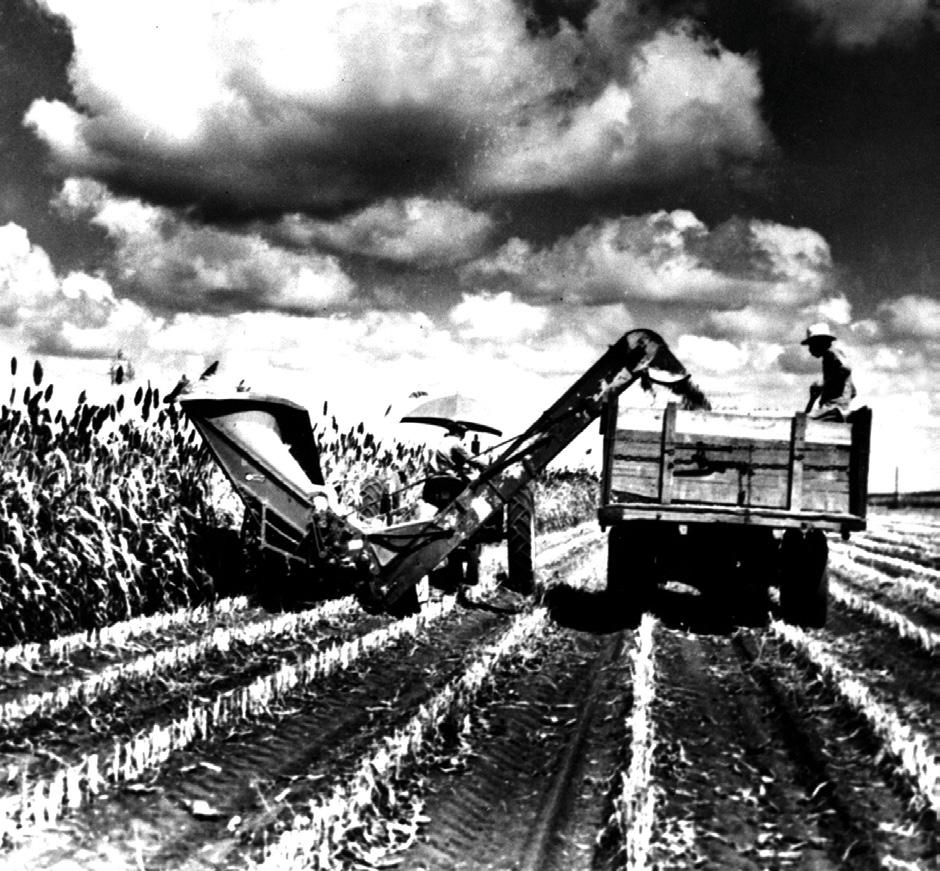
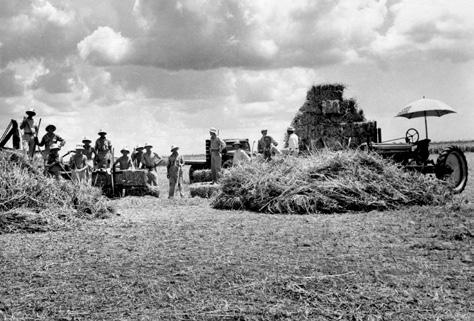
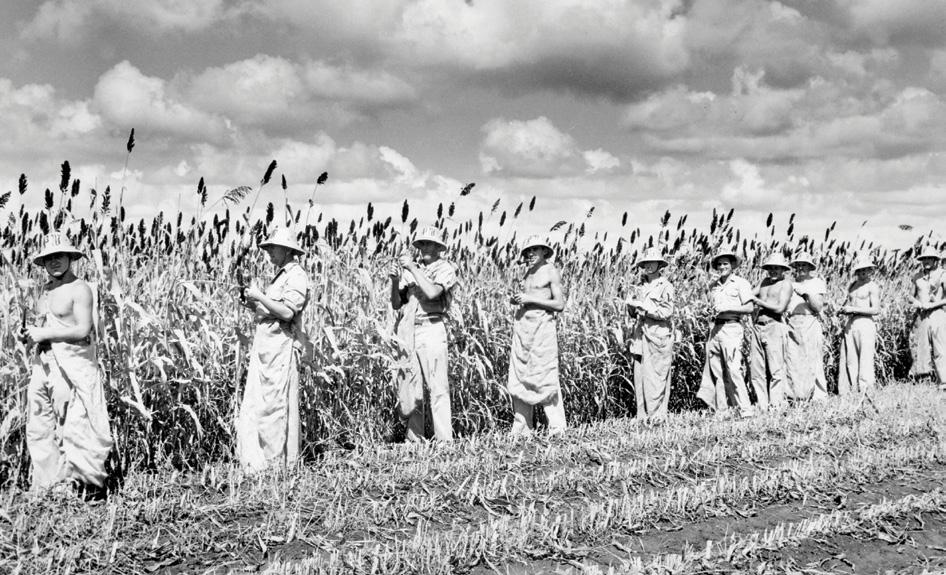
Life as a 4 5 prisoner of war POWs working in the field at the George Ranch WORKING POW
ROSENBERG MAGAZINE COMMUNITY prisoner of war
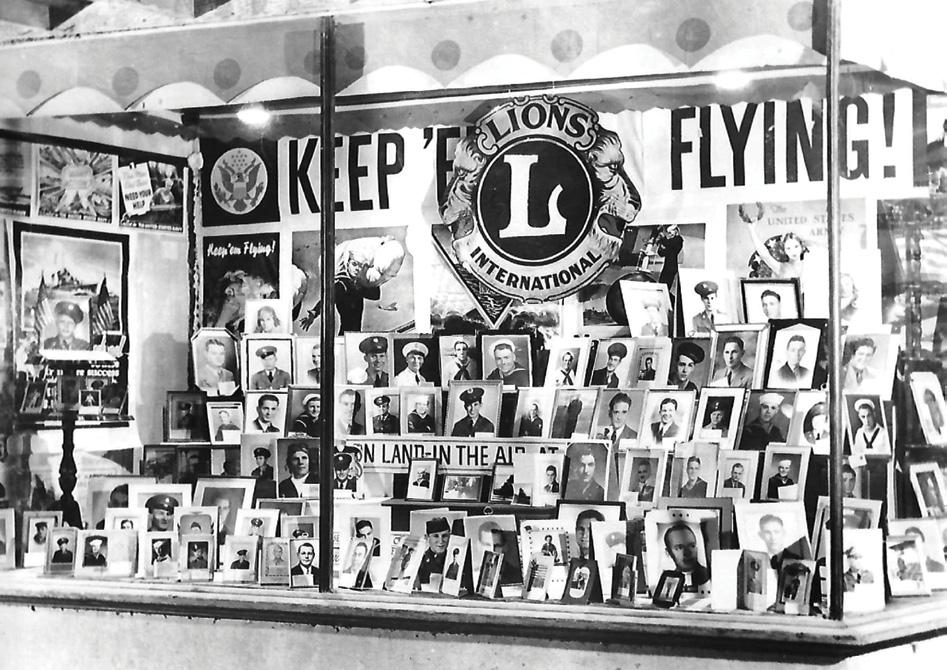
Storefront with photos of Fort Bend soldiers serving during WWII
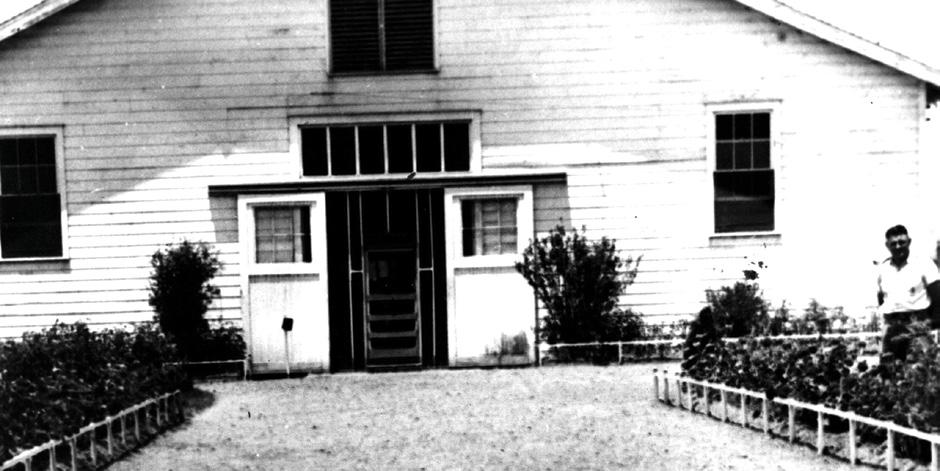
Entrance to the POW Barracks in Rosenberg, TX
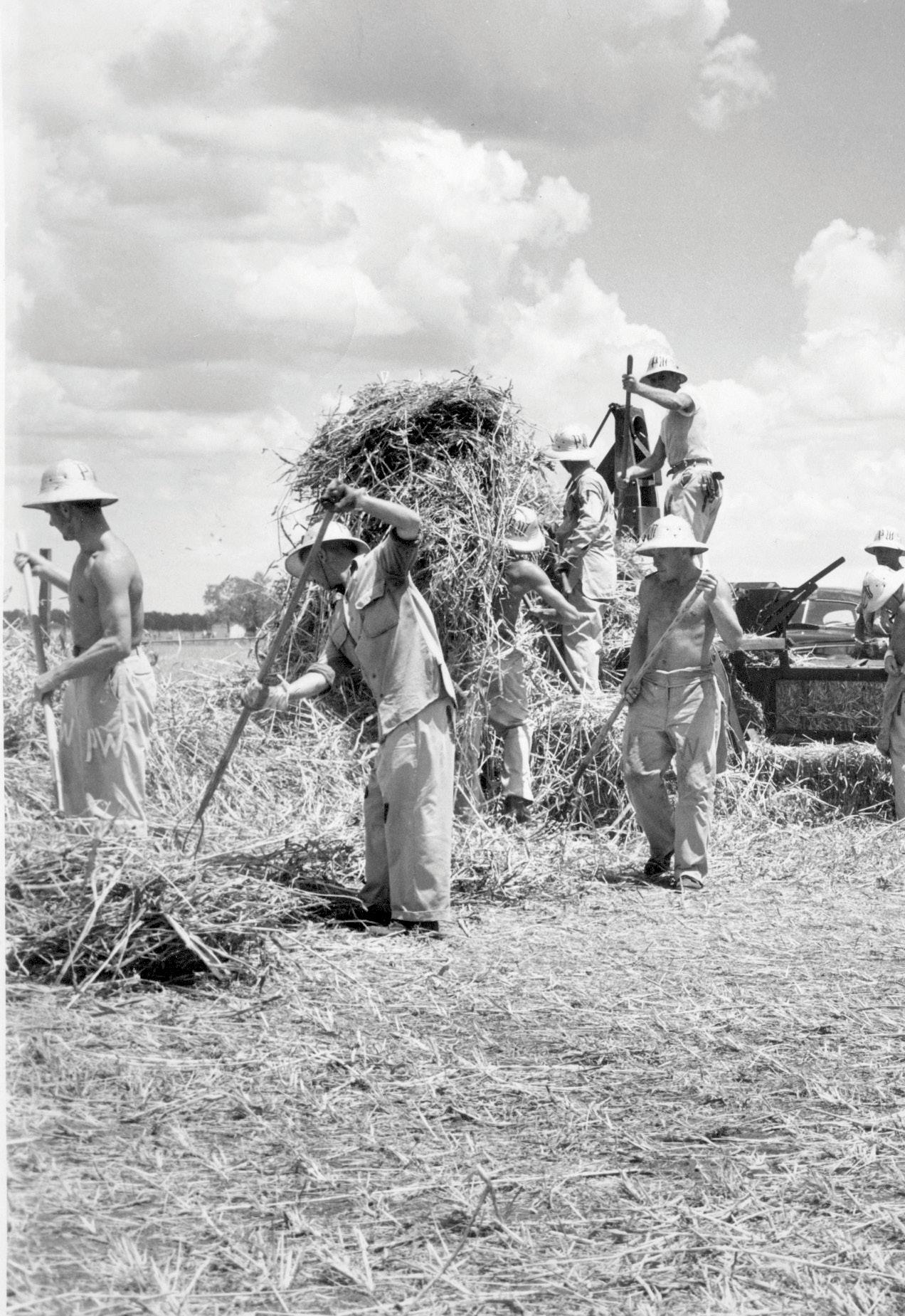
Others confirmed they sang as they marched to and from work readily obeying commands. The men usually dressed in Afrika Korps shorts and caps, or in blue fatigues with “PW” printed in large letters on their backs. Their professions included sign painter, piano tuner, shoe cobbler, mathematician, artist and merchant and once they were settled, all volunteered to work in the community. Many had served two to three years of service to Germany prior to being captured. Most were married and had children. Evenings were often devoted to classes in a variety of subjects, including piano, and some transferred university credit hours back to Germany after the war. Camp newspapers were written in German and printed in most camp locations, but German speaking interpreters among the American guards were scarce. Many of the POWs felt anxious when there was not sufficient work and still others felt abandoned by their own country and despised by the captors. Despite this, they seldom displayed aggressive behavior.
Allied Victories Bring More POWs
The Normandy Invasion, which occurred the following June, sent the POW numbers soaring to 30,000 a month across America. This continued through December. By the last months of the European War, the count had climbed to 60,000 a month. By the end of the war, America held more than 400,000 enemy captives in 511 camps. Records show the POWs contributed 90,629,233 man days of labor between mid-1943 to December 1945 for a government savings of more than $131 million.
Retired pharmacist Johnny Scott of Rosenberg recalls having lunch with some 50 of the men. He accompanied the late local businessman Raymond Rude to the POW camp. Rude knew the commanding officer. “The visit occurred while I was home on leave,” said Scott, explaining he was attired in his Navy officer uniform. “I remember the men saluting me in military manner and with respect.” The majority of military police who worked as guards came from the 21st Battalion in Houston. Captain Richardson was the officer of camps in the area including those in Wharton, Alvin and Bay City.
Putting the POWs to Work
Prisoners in the Alvin camp constructed an irrigation canal for rice farms and worked in the cannery. Others planted oak trees. In Clodine, a grain dryer for the rice was built.
Retired pecan farmer Andy Anderson recalls helping his father, Newell Anderson, when he was a youngster. Riding with his father in the pickup he could see the prisoners being escorted to their work stations. “These men were building the Clodine rice dryer and the officers were in charge of the blueprints.” He continued, saying “I remember listening to Edward R. Murrow’s commentary on my head crystal set that German soldiers were mean and dangerous. And then I would see their calm, clean and smiling faces and I would feel confused.”
“For the soldiers, there was usually one guard with one rifle.” said Anderson, adding he can recall being told that the rifle didn’t have any ammunition. “I was told that as they built the dryer with only one tree to shade them. They built a lookout station in the tree and took turns watching for the morning and afternoon guard checks, while the others swam in the rice canal. The POWs would bang on sheets of tin when the checkers would approach. Lunch was delivered daily at noon. They were not allowed to wear watches, so they used a sundial.”
County Judge Hunter Harris, the father of Richmond resident Billie Wendt and grandfather to Richmond’s Mayor Evalyn Moore, was raising potatoes in Fulshear (Weston Lakes) and hired some of the men to assist with the sorting of the annual harvest. “I can recall he was unable to attend my college graduation because he was in charge of a Fort Bend County Blackout,” said Wendt. “During a blackout, you couldn’t even light a candle in your home,” said retired newspaper family editor Betty Dawes Humphrey. While often waiting for her father to return home from work in Freeport, she and her siblings would have occasion to wave at the POWs in the fields.
Paying the POWs
By 1944, new labor contracts offered the men 25 cents an hour and transportation. In Texas, as well as other states, while the public utilized their red meat stamps and counted their ration points, white bread and coffee (items rarely found in American kitchens and far better than American troops had on the front lines) were served in the camps. Army rations were served with the bread and coffee. The reason for allowing this, according to the Journal of International Law, was to better the way our own soldiers would be treated. Post war, it was discovered that other countries had declined to pay American POWs for their labor.
Fort Bend farmers had to sign up for as many as 10 prisoners at a time. Rice farmers willingly paid 40 cents an hour for 10-hour days. They supplied the transportation and the Army supplied the guards and food.
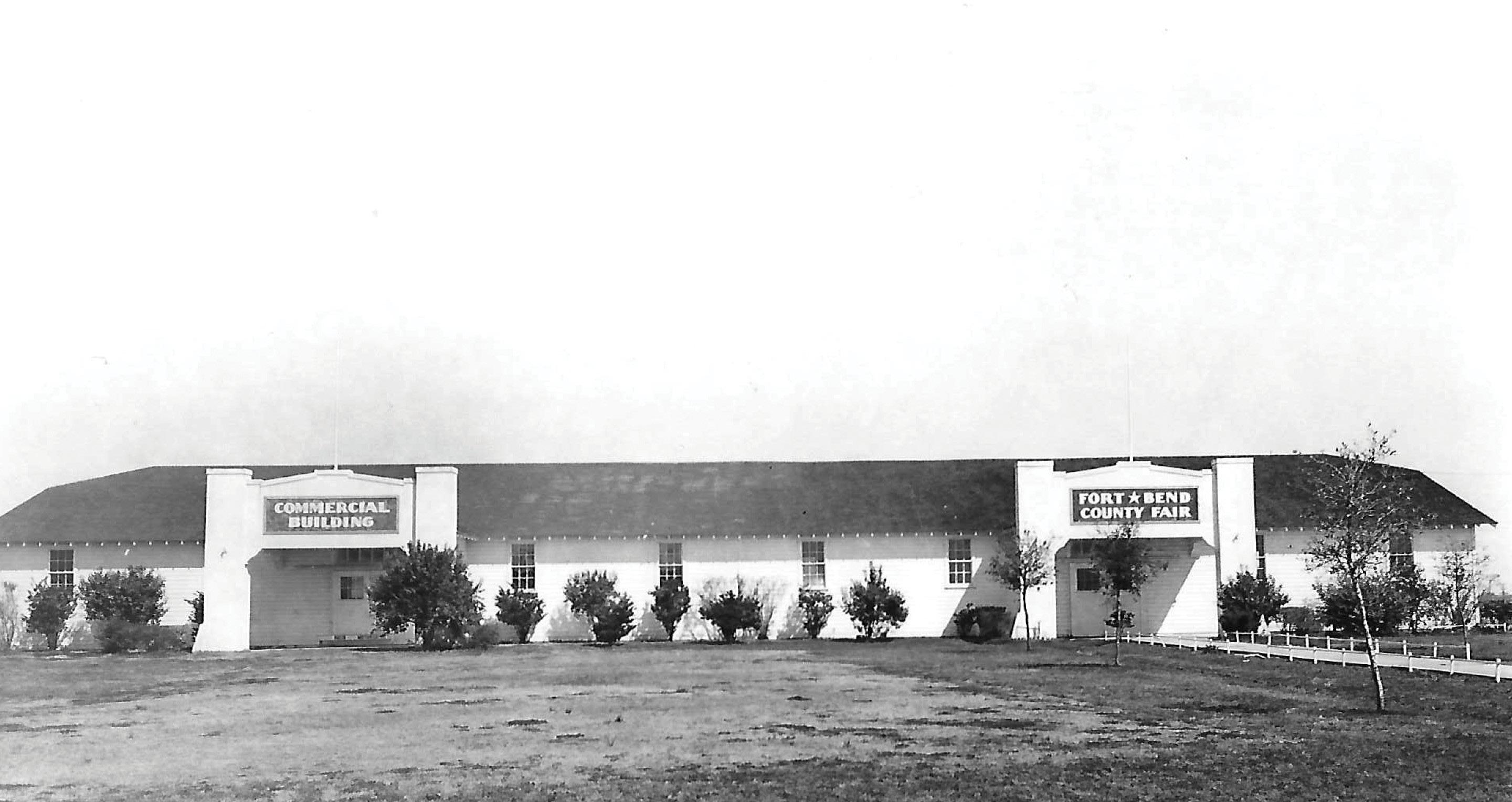
According to various records, 50 prisoners were contracted to Sugarland Industries planting cabbage, and another 100 were contracted for 60 days at 25 cents an hour. One hundred prisoners were hired by Richmond Irrigation Company for 60 days at 40 cents an hour. A few earned up to 80 cents per day. With monies earned they purchased soap, hair oil, and personal items which often included two bottles of beer a day at 10 cents a bottle, along with cigarettes.
Other Area POW Camps
Two-thirds of the POW camps in America were located in the South and Southwest of which 120 camps were located in Texas. Word passed quickly that Adolph Hitler’s soldiers were clean, neatly dressed and polite. More than 1,000 of the Japanese POWs were shipped to Kenedy.
Camp Mexia was the largest Texas camp. The others included Tyler, Hearne, Kaufman, El Campo, Bastrop, Gainesville, Abilene, and Marfa. Over 6,000 Italian soldiers were captured in Tunisia and held at Hearne.
From Fairground to POW Camp
In Fort Bend county, Rosenberg was the largest city and strategically situated, so the Fort Bend county Fairgrounds proved to be an ideal accommodating facility. It was located where Fiesta is today, across from Amegy Bank on Avenue H, and north to the railroad tracks. Built in 1933, the one-story wood structures and acreage provided ample room and there would not be any conflicting situations. The fair had been cancelled because of the war.
Retired rice farm and rancher William Vallet, a member of the State Guard, recalled he was 36 and farming near Beasley when a crew of local men was recruited by Commissioners Court to shingle newer additions to the fairgrounds meet accommodation requirements for the prisoners and guards. The crew also fenced the grounds and prepared the roads. On September 30, 1942, the first POWs arrived by rail in Rosenberg.
POWs Across Texas
Many other counties offered their fairgrounds, auditoriums and vacated buildings as well.
The nation had never held large numbers of foreign prisoners of war in its entire history and was unprepared. The responsibility included feeding, registering, clothing, housing, entertaining, and reeducating POWs for the length of war. Numerous government agencies competed for jurisdiction over POW programs which created even more confusion.
Some Texans were apprehensive. With their fathers, husbands, sons and brothers away in battle daily work
ROSENBERG MAGAZINE COMMUNITY prisoner of war
and chores needed completing and workforces were scarce. Residents began to refer to the camps as the “Fritz Ritz.”
More than 150,000 POWs arrived after the North African campaign and an average of some 20,000 arrived monthly between May and October in 1943.


Headlines from “The Texas Coaster” newspaper
The Need for Laborers
Texas farmers had followed the attack on Pearl Harbor (1941) and had sent food supplies, the largest reserve supplies in history, to the front lines. Radio stations kept the public aware of the “Back the Attack” campaign, but as the war continued it seemed more futile.
Crops needed planting, tending and gathering, hay needed baling, pecans needed picking, and meat packing plants were vacant. As early as July 1943, The Rosenberg Herald (today the Fort Bend Herald) ran advertisements for farm labor assistance, but the ads went unanswered. With so many engaged in war, nervous farmers began battling a critical labor shortage, which was made worse by the Army’s red tape and delays in getting approval for the POWs to work.
Many other items were in short supply as well. Consequently, a group of farmers insisted on emergency assistance. A local labor committee composed of Julius Junker, W.V. Dungan, Jimmy Miller, County Judge Hunter P. Harris, W.G. Wendt, C.I. Snedecor, and County Agent H.B. Ross, urged the farmers and ranchers to meet July 13 to sign a petition that would be sent to Austin. Products such as tires, gasoline and batteries were becoming more and more scarce.
Community Relations
Back at the POW Camp, townspeople could often be seen standing outside the fences talking to the prisoners. Many noted that prisoners read American publications through interpreters and that some also utilized small radios that were allowed in the barracks. Political viewpoints could not be expressed between the POWs and local residents. “I remember them playing volleyball and German football, which was much like our game of soccer,” added retired Lamar history teacher Dick Haygood. “The strict discipline of the German army was bred into these men even more than a lot of our soldiers.”
After the War
In November 1945 the POWs left Rosenberg and Texas by rail for Long Beach, California at a rate of 50,000 men a month. Their goals were to return to their families and rebuild their war-damaged cities. In January, 1946, they sailed in ships and arrived in Liverpool, Great Britain. After Easter, 1946, they were no longer POWs and were released to return to Germany.
Upon returning home they found family members and millions of Germans dying from starvation. “There is nothing but hunger and misery,” penned one POW in a letter to Mamie George at the George Ranch. “as long as we were POWs we always had something to eat and wear.”
Another former POW wrote: “Life was good (in America), except for barbed wire, but it was definitely better (for us) than for the German POWs held in the Soviet Union.”
The Rosenberg POW encampment was demolished when a new Fort Bend County Fairgrounds was constructed along SH 36S and the intersection of Band Road outside the city limits. The city’s first Kmart filled the former location and later it became Fiesta, which continues as a site marker.
POWs who died from wounds or natural causes were buried in the Fort Sam Houston National Cemetery in San Antonio.
Historical Remnants
Two cedar chests, once owned by POWs who worked on the George Ranch, were identified in the George home, and the Fort Bend History Museum is the home to a chair and another small chest. Heavy table and chair sets made by the POWs also remain in a few area homes.
Jerry Humpola, a local photographer during the era, captured albums of photos of the men during their stay at the Rosenberg POW camp and at their many worksites. Postcards were also made. After his death, his wife Margaret kept the collection of negatives, but over the years many were ruined by moisture.
As years passed, it was not uncommon for the former POWs to show up at her doorstep. They had returned with their families to show them where they had been held captive. She told of one man who arrived at her shop and handed her a postcard. She instructed him to turn it over and there were their lines. It had come full circle. v
Photos Courtesy of The George Memorial Library, Richmond, TX. Photos Courtesy the George Ranch Historical Park Richmond, TX. Photos Courtesy of the William C. Butler Collection - Humpola Photography, Rosenberg, TX.











